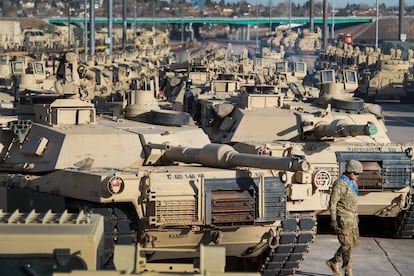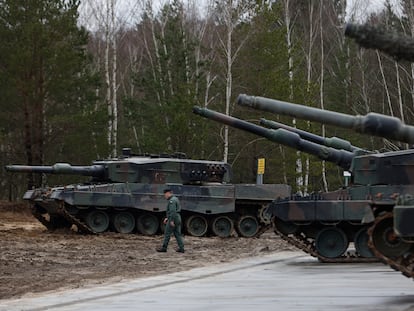The Pentagon speeds up Abrams tank delivery to Ukraine war zone
The aim is to get the 70-ton battle powerhouses to the Russia-Ukraine war zone in eight to 10 months

The Pentagon is speeding up its delivery of Abrams tanks to Ukraine, opting to send a refurbished older model that can be ready faster, with the aim of getting the 70-ton battle powerhouses to the war zone in eight to 10 months, U.S. officials told The Associated Press.
The original plan was to send Ukraine 31 of the newer M1A2 Abrams, which could have taken a year or two to build and ship. But officials said the decision was made to send the older M1A1 version, which can be taken from Army stocks and could be there before the end of the year. Officials said the M1A1 also will be easier for Ukrainian forces to learn to use and maintain as they fight Russia’s invasion.
The officials spoke on Tuesday on the condition of anonymity because the plan has not yet been publicly announced. Pentagon officials are expected to make the announcement Tuesday.
The Biden administration announced in January that it would send the tanks to Ukraine — after insisting for months that they were too complicated and too hard to maintain and repair. The decision was part of a broader political maneuver that opened the door for Germany to announce it would send its Leopard 2 tanks to Ukraine and allow Poland and other allies to do the same.
It’s unclear how soon the U.S. would begin training Ukrainian forces on how to use, maintain and repair the tanks. The intention would be to have the training of the troops coincide with the refurbishment of the tanks, so that both would be ready for battle at the same time later this year. The Pentagon will also have to ensure that Ukrainian forces have an adequate supply chain for all the parts needed to keep the tanks running.
Any delivery of the tanks would not likely happen in the spring months, when both Russia and Ukraine are expected to launch more intensive offensives. The two sides have been largely in a stalemate, trading small slices of land over the winter.
The fiercest battles have been in the eastern Donetsk region, where Russia is struggling to encircle the city of Bakhmut in the face of dogged Ukrainian defense. Local Gov. Petro Kyrylenko on Tuesday said on Ukrainian TV that Russian shelling there over the previous day killed one civilian and wounded another.
During a visit to the Lima, Ohio, tank plant in February, Army Secretary Christine Wormuth met with officials there at length to determine the best options for getting the tanks to Ukraine.
“Part of it is figuring out — among the different options — what’s the best one that can allow us to get the Ukrainians tanks in as timely a fashion as we can,” without disrupting foreign military sales, Wormuth said at the time.
Officials at the plant, which is owned by the Army and operated by Reston, Virginia-based General Dynamics, said production totals can vary, based on contract demands. And while they are currently building 15-20 armored vehicles per month, including tanks, they can easily boost that to 33 a month and could add another shift of workers and build even more if needed.
Development of tanks for Ukraine would have to be squeezed in between the current contracts for foreign sales, which include 250 of the newest versions for Poland and about 75 for Australia. During Wormuth’s tour of the facility, workers were preparing to build an updated version of the vehicle for Poland.
Ukrainian leaders have persistently pressed for the Abrams, which first deployed to war in 1991 and has thick armor, a 120 mm main gun, armor-piercing capabilities and advanced targeting systems. It runs on thick tracked wheels and has a 1,500-horsepower turbine engine with a top speed of about 42 miles per hour (68 kilometers per hour).
Sign up for our weekly newsletter to get more English-language news coverage from EL PAÍS USA Edition
Tu suscripción se está usando en otro dispositivo
¿Quieres añadir otro usuario a tu suscripción?
Si continúas leyendo en este dispositivo, no se podrá leer en el otro.
FlechaTu suscripción se está usando en otro dispositivo y solo puedes acceder a EL PAÍS desde un dispositivo a la vez.
Si quieres compartir tu cuenta, cambia tu suscripción a la modalidad Premium, así podrás añadir otro usuario. Cada uno accederá con su propia cuenta de email, lo que os permitirá personalizar vuestra experiencia en EL PAÍS.
¿Tienes una suscripción de empresa? Accede aquí para contratar más cuentas.
En el caso de no saber quién está usando tu cuenta, te recomendamos cambiar tu contraseña aquí.
Si decides continuar compartiendo tu cuenta, este mensaje se mostrará en tu dispositivo y en el de la otra persona que está usando tu cuenta de forma indefinida, afectando a tu experiencia de lectura. Puedes consultar aquí los términos y condiciones de la suscripción digital.
More information
Archived In
Últimas noticias
There is as much life left to discover on planet Earth as that which is already known
Dozens presumed dead, around 100 injured in fire at Swiss Alps bar during New Year’s celebration
Is porn for women different from conventional porn? We spoke to those who make it
Cartagena de Indias is sinking: What can the city do to mitigate it?
Most viewed
- Sinaloa Cartel war is taking its toll on Los Chapitos
- Reinhard Genzel, Nobel laureate in physics: ‘One-minute videos will never give you the truth’
- Oona Chaplin: ‘I told James Cameron that I was living in a treehouse and starting a permaculture project with a friend’
- David King, chemist: ‘There are scientists studying how to cool the planet; nobody should stop these experiments from happening’
- Why the price of coffee has skyrocketed: from Brazilian plantations to specialty coffee houses










































